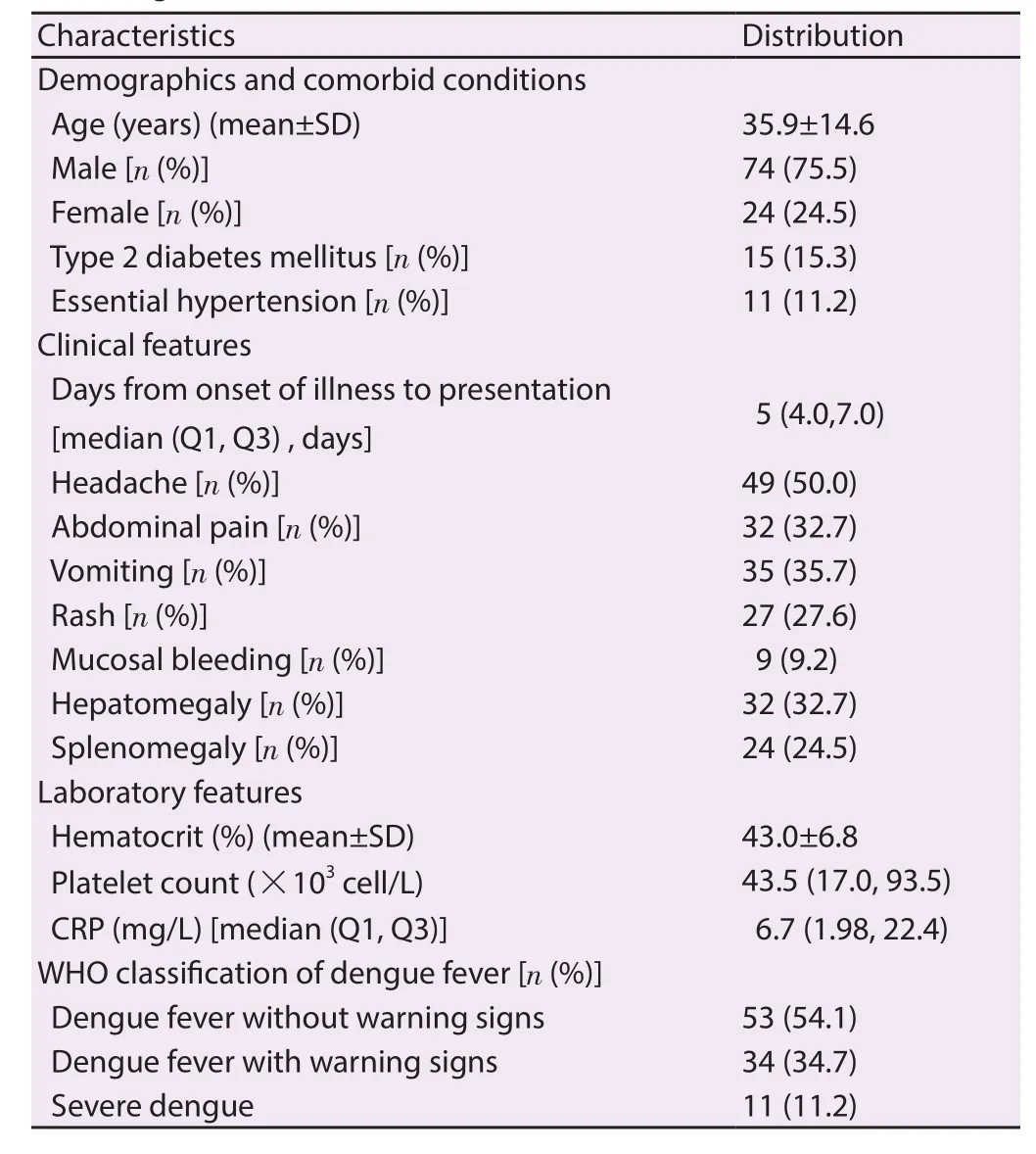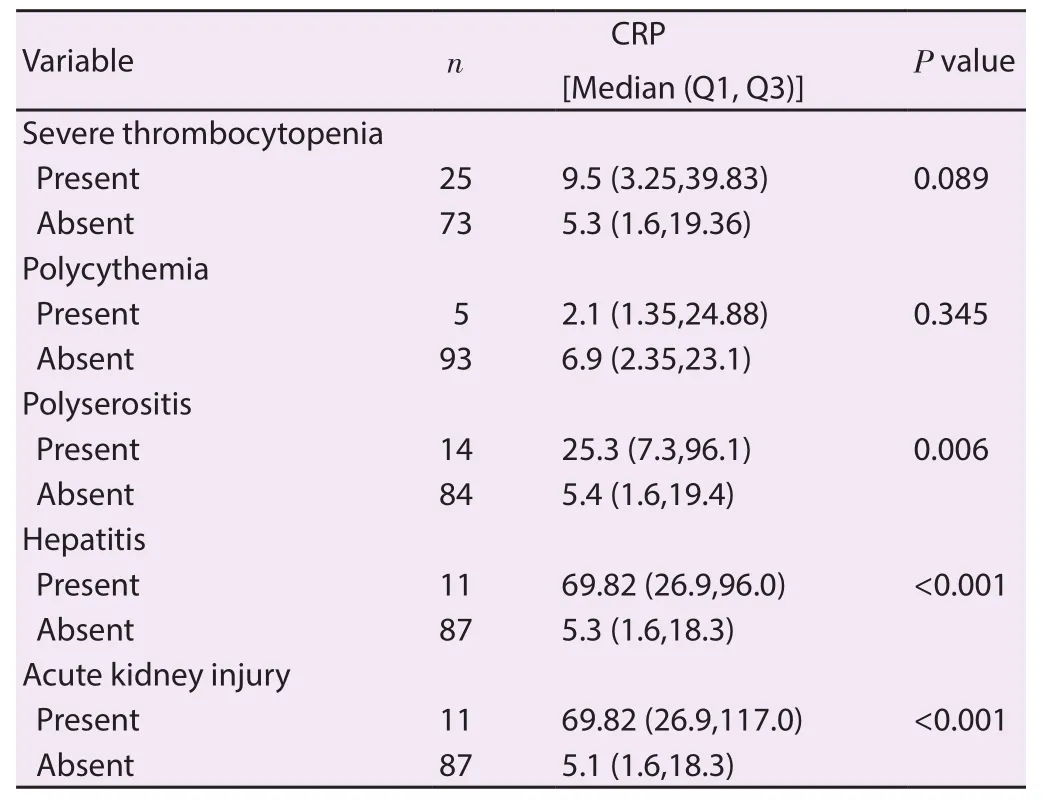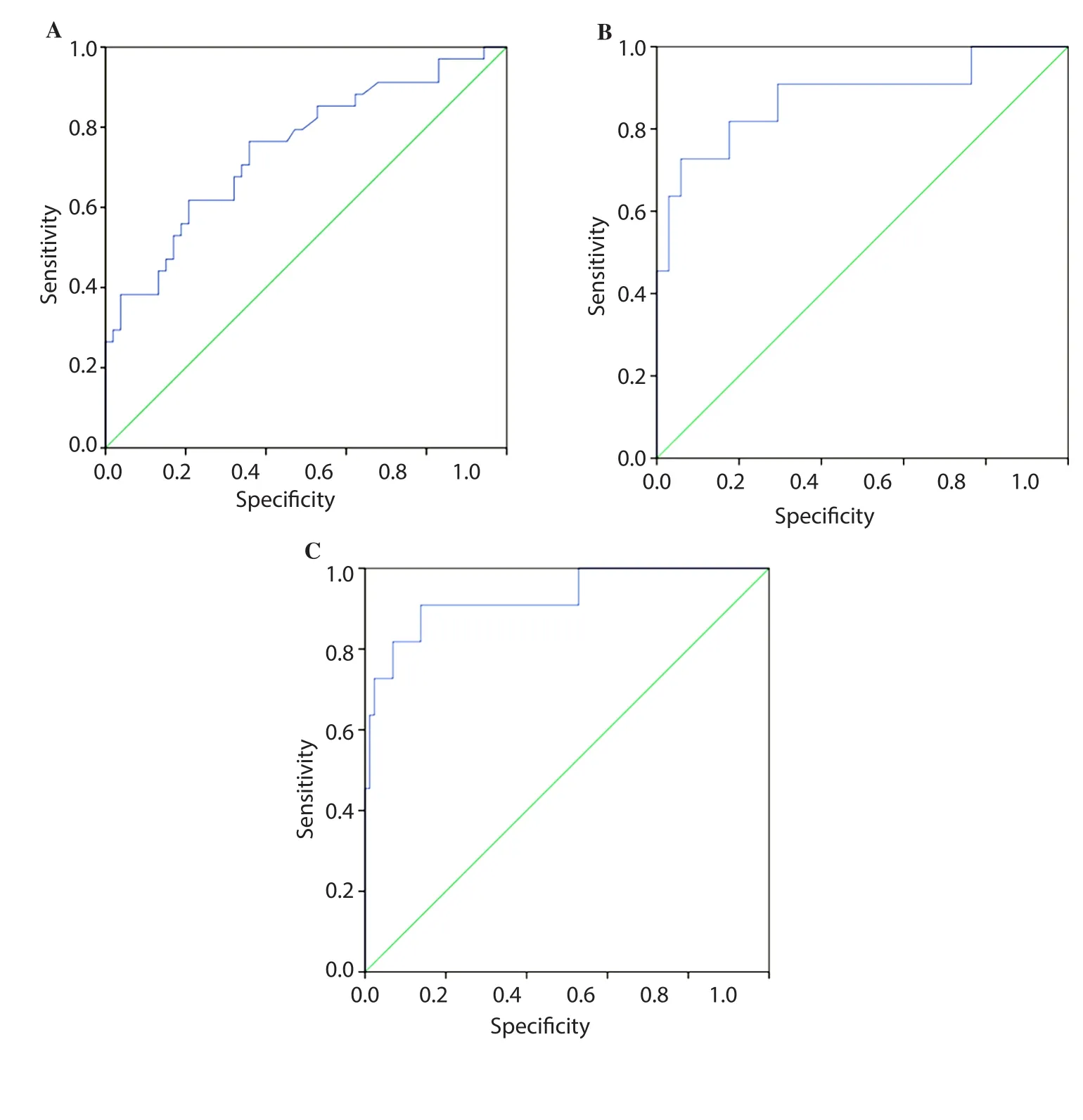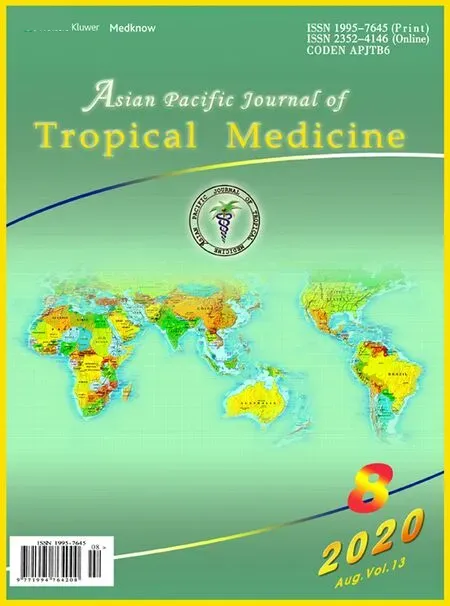Diagnostic performance of C-reactive protein level and its role as a potential biomarker of severe dengue in adults
Raghavendra Rao, Snehal Nayak, Akhilesh K Pandey, Shobha U Kamath
1Department of Medicine, Kasturba Medical College, Manipal, India
2Manipal Academy of Higher Education, Manipal, India
3Department of Biochemistry, Kasturba Medical College, Manipal, India
4Department of Community Medicine, Kasturba Medical College, Manipal, India
ABSTRACT Objective: To determine the relationship between C-reactive protein(CRP) level and the severity of dengue and the potential use of CRP in predicting acute dengue infection.Methods: A prospective observational study was performed on dengue patients admitted to a tertiary care hospital in southern India.All patients of age above 18 years, diagnosed with dengue were included in the study. The detailed laboratory parameters pertaining to dengue were recorded. CRP levels were estimated and compared between groups i.e. severe and non-severe dengue. CRP cut-offvalue was detected using the receiver-operator curve.Results: Totally 98 patients with a mean age of 40 years were included. Among them, 11.2% of the patients suffered from severe dengue, 54.1% of the cases had non-severe dengue without warning signs, and 34.7% had non-severe dengue with warning signs. The median CRP was signi ficantly higher in patients with severe dengue compared to patients with non-severe dengue (96.2 mg/dL vs. 5.3 mg/dL). Univariate logistic regression analysis showed that the odd’s ratio (OR) of CRP was 1.053 (P≤0.001, 95% CI=1.029-1.078). CRP at a cutoff value of 21.6 mg/L (0.929 AUC) had excellent sensitivity (100%) and specificity (81.6%) in predicting severe dengue infection. Multivariate logistic regression analysis showed that CRP (OR=1.089, P=0.013) and ALT (OR=1.010,P=0.034) were statistically signi ficant independent predictors of dengue severity.Conclusions: CRP level could be used as a potential biomarker to predict severity of dengue in adults.
KEYWORDS: Vector-borne; Arbovirus; Inflammation;Biochemical; Tropical disease
1. Introduction
Dengue is one of the most signi ficant vector-borne viral diseases worldwide. According to the World Health organization (WHO),dengue is a global public health challenge with higher prevalence in tropical and subtropical countries[1]. Approximately 2.5 billion people worldwide reside in high-risk dengue transmission areas with around 400 million infections occurring annually and the mortality rate is about 5%-20%[1]. South-east Asia and the Western Paci fic account for around 75% of the current global burden of dengue[2].Dengue is transmitted by two species of Aedes mosquitoes- Ae.aegypti and Ae. albopictus. Dengue virus (DENV) belongs to the family Flaviviridae. There are four anti-genetically distinct DENV serotypes DENV-1, DENV-2, DENV-3, and DENV-4, all are responsible for the infection[3]. According to the WHO classi fication in 1997, clinical manifestation of dengue includes non-specific febrile illness, dengue fever (DF), dengue hemorrhagic fever, and dengue hemorrhagic shock or dengue shock syndrome (DSS)[4,5].
However, the classi fication was revised by the WHO in 2009 based on the complexity of dengue and accordingly dengue patients were classi fied into two groups: non-severe dengue (with and without warning signs) and severe dengue (with warning signs[6,7]. Dengue is now endemic in most of the states of India and is one of the leading causes of hospitalization, especially during the monsoon. National Vector Borne Disease Control Program had reported approximately 100000 laboratory con firmed cases of dengue in India in the year 2016[8]. The resurgence of dengue over the last few decades mostly resulted from demographic and societal changes including unplanned and uncontrolled urbanization, deterioration of waste management systems, global warming, inefficient mosquito control, hostpathogen interactions, and population immunological factors[1,3].Frequent outbreaks and high burden of disease have serious impact on the country’s economy and there is a need for prevention, early case detection, and control of this widespread disease.
Early case classi fication of dengue is essential for triage, appropriate treatment, and also for making decision regarding the requirements of hospital admission for the management of patients. These aspects are signi ficant in case of sudden outbreak of the disease especially in resource limited health care setups. However, early recognition of dengue is highly challenging because the initial dengue symptoms are mostly non-speci fic and viremia remains lower than detectable levels[9]. Moreover, there is no accepted clinical guideline or speci fic laboratory test for the early prediction of the severity of dengue[9]due to broad clinical manifestations of DENV resulting from their unpredictable clinical evolution and outcomes[4]. At present, warning signs laid down by the WHO is being used as a key in assessing the severity, despite its low sensitivity in the early phase. Therefore, a reliable, simple biomarker is essential for the clinicians for effective management of the patient at early phase of dengue.
C-reactive protein (CRP) is an acute phase protein synthesized in all in flammatory conditions or in tissue injury. CRP is produced by the liver within six hours of onset of in flammation[4]. Nonetheless,the level diminishes exponentially over 18-20 hours, close to the half-life of CRP, with the depletion of stimuli[10]. The increase in serum CRP level is as high as 1000 fold following infections of some speci fic bacteria[10]. CRP is a homo-pentameric protein, which dissociates irreversibly into five separate monomers at the sites of infection or in flammation. CRP, in presence of calcium binds with phosphocholine on microorganisms and stimulates the complement pathway of innate immunity resulting in in flammatory processes and host responses to infection[10]. Hence, CRP is considered as a biomarker for infection or in flammation[11]. CRP is clinically used to differentiate between viral and bacterial infection[4] and even to distinguish malaria from dengue fever in endemic areas[12]. Several studies reported that CRP levels are altered in severe dengue. A recent study in Taiwan detected an increase of CRP levels in dengue
patients in early stage of infection and CRP cut off value showed an excellent sensitivity in predicting DSS and severe dengue[4]. Hence,a single measurement of CRP was proven to be a potentially useful biomarker to identify patients at risk of developing severe dengue and thereby facilitating patient management. Another study showed an elevated CRP level among pediatric dengue patients[13], although no comparison was made across groups of dengue patients based on severity. Additionally, signi ficantly higher level of CRP was detected in early phase dengue patients with plasma leakage compared to dengue patients without plasma leakage[14]. All these results indicated the importance of estimation of serum CRP levels in dengue patients in order to improve the case classi fication of dengue by severity.
Till date, only few studies were done to assess using CRP testing to distinguish between mild and severe dengue cases in adult populations. The objective of this study was to measure the CRP level in adult dengue patients in order to detect the importance of CRP in classifying dengue patients based on severity of illness, so as to consider CRP as a reliable, potential biomarker for predicting acute dengue at early phase.
2. Materials and methods
2.1. Study design
A prospective observational study was conducted by clinical investigation in the Department of Internal Medicine at a tertiary care hospital, in Karnataka, India for a one-year period from June 2017 to June 2018.
2.2. Ethics statement and informed consent
The study was approved by the Institutional Ethics Committee(IEC number: 353/2018). The patients were recruited in the study following prior permission from the Head of the Department of Medicine in the tertiary care hospital. A participant information sheet containing the particulars of the study was provided to all the patients and the objectives of the study were explained to them. Informed consent was taken from all the patients. Participant information sheet and informed consent were available in English and also in the local Kannada language. The details of the reports were kept completely con fidential.
2.3. Participants with selection criteria
Adult patients diagnosed with dengue, who were admitted in a tertiary care teaching hospital, in Karnataka, India were included in this prospective study. Inclusion criterion for the study was the patients more than 18 years of age and dengue-positive. Exclusion criteria for the study were: (1) patients below the age of 18 years,(2) patients with autoimmune disorder, (3) patients with secondary bacterial infections, and (4) patients discharged against medical advice.
2.4. Sample size
The sample size of the participates was calculated using the formula,n=Z2α/2*p*(1-p)/MOE2, where Zα/2is the critical value
of the normal distribution at α/2, MOE is the margin of error, p is the sample proportion, and n is the sample size. Considering the prevalence of dengue to be 8% with 6% margin of error and 95%confidence interval, the sample size was calculated. The sample size to be achieved was 81. Totally, 114 patients were selected for this study, out of which 6 patients were discharged against medical advice and 10 patients did not provide consent for the study. The actual sample size for this study was thus 98 (Figure 1).

Table 1. WHO revised criteria for classi fication of severity of dengue[15]*.

Figure 1. Diagram of participates evaluated and enrolled in this study.
2.5. Data collection
Demographic details such as age and sex, clinical characteristics such as symptoms, bleeding manifestations, comorbidities, general and systemic examination findings, and laboratory investigations including complete blood pro file, renal function tests, liver function tests, CRP level, electrocardiogram, chest x-ray, ultrasound of abdomen, and coagulation parameters were recorded in a predesigned proforma.
2.6. Dengue illness severity
All the patients were classi fied according to the severity of dengue based on the 2009-revised WHO criteria[15] as non-severe and severe dengue (Table 1). The non-severe dengue group was further categorized as dengue with warning signs and dengue without warning signs. The number of cases in severe dengue group, dengue with warning signs and dengue without warning signs were 11, 34 and 53 respectively. CRP level of all the recruited patients were estimated and were compared among each group based on dengue severity.
2.7. Laboratory methods
Serum samples from all the study participants were tested for DENV infection. Confirmation of dengue positivity was done by assessing dengue-specific immunoglobulin M or IgM antibody using a kit from National Institute of Virology, Pune. Alternatively,presence of dengue non-structural glycoprotein-1 antigen was tested using Pan bio ELISA kit.
The CRP level of patients was estimated in the hospital via an extremely sensitive assay called immunoturbidimetric assay using Roche/Hitachi Cobas c systems.
2.8. Statistical analysis
All categorical variables were analyzed and reported in the form of frequency and percentages and continuous variables were presented as mean±standard deviation and median, where required. Mann-WhitneyUtest was used to analyze the difference between the medians of two groups (severe and non-severe dengue). Receiver operating characteristic curve was used to derive the cutoff value of CRP for severe and non-severe dengue group and also to know the speci ficity and sensitivity of the test. The area under the curve (AUC)between 0.50-0.60, 0.60-0.70, 0.70-0.80, 0.80-0.90 and 0.90-1.00 was de fined as failing, poor, fair, good and excellent, respectively.TheP-value <0.05 was considered to be statistically significant.Data was analyzed using SPSS 23.0 (IBM SPSS statistics, USA)software. Student’st-test was performed to compare the mean CRP level in different groups.
3. Results
3.1. Patient demographic and baseline characteristics
As shown in Table 2, the mean age of patients who were diagnosed with dengue fever was (35.9±14.6) years with male preponderance;74 out of 98 (75.5%) were males and 24 (24.5%) were females. The most common symptoms were headache (50.0%, 49/98), abdominal pain (32.7%, 32/98) and vomiting (35.7%, 35/98). Mucocutaneous rash was seen in approximately 27.6% of the cases, with mucosal bleeding in around 9.2% of the cases. Hepatomegaly (35.7%)and splenomegaly (24.5%) were common findings on systemic examination. Fifty-three patients (54.1%) had dengue fever without warning signs and 34 (34.7%) had dengue fever with warning signs.Severe dengue accounted for only 11.2% (11/98) of the cases.

Table 2. Demographic and baseline characteristics of patients diagnosed with dengue fever (n=98).
3.2. Predictors of severity of dengue
Univariate logistic regression analysis was done for all categorical and continuous variables. Only those significant have been mentioned. Totally four parameters were includedi.e.ALT, serum albumin, total leucocyte count and CRP withOR=1.005 (P=0.001,95%CI=1.002-1.009),OR=0.114 (P≤0.001, 95%CI=0.034-0.381),OR=1.000 (P=0.001, 95%CI=1.0-1.0) andOR=1.053 (P≤0.001,95%CI=1.029-1.078) respectively. Multivariate logistic regression analysis showed that CRP (OR=1.089, 95%CI=1.018-1.166,P=0.013) and ALT (OR=1.010, 95%CI=1.001-1.018,P=0.034) were statistically signi ficant independent predictors of dengue severity.Serum albumin and total leucocyte count were not included in the multivariate regression analysis model due to correlation with CRP levels.
3.3. CRP levels
The mean CRP level was 22.2 mg/L. The median CRP level of 96.2 mg/L (38.9,124.0) in the severe dengue group was signi ficantly higher compared to CRP level of 5.3 mg/L (1.6,8.3) in the non-severe dengue group withP<0.001(Mann-WhitneyUtest). The CRP cutoffvalue of 5 mg/L (0.748 AUC) for dengue without warning signs(n=53/98) versus dengue with warning signs (n=34/98) (Figure 2A)had a sensitivity of 76.5% and a speci ficity of 64.2% demonstrating that CRP level could be used to differentiate these two groups. The CRP cutoff value of 28 mg/L (0.877 AUC) for dengue with warning signs (n=34/98) versus severe dengue (n=11/98) had a sensitivity of 90.9% and a speci ficity of 70.6% (Figure 2B). The CRP cutoff value of 21.6 mg/L (0.929 AUC) for non-severe dengue(n=87/98) versus severe dengue (n=11/98) as in Figure 2C had an excellent sensitivity of 100% and a speci ficity of 81.6% highlighting the usefulness of CRP level in differentiating severe form of dengue from a milder form.
3.4. Complications of dengue fever and CRP levels
Median CRP level was compared for all different complications of dengue fever using Mann-Whitney U test. As represented in Table 3,statistically signi ficant difference in median CRP level was observed in patients with polyserositis (P=0.006), hepatitis (P<0.001) and acute kidney injury (P<0.001)), asP<0.05 is considered to be statistically significant. Median CRP value was not calculated for complications like myocarditis, pancreatitis and ARDS due to less number of cases. However, mean CRP levels were more than 100 mg/L in myocarditis (117.0 mg/L), pancreatitis (104.0 mg/L), and acute respiratory distress syndrome (ARDS=126.6 mg/L).

Table 3. Comparison of median C-reactive protein levels in different complications of dengue fever.

Figure 2. Receiver-operating characteristic(ROC) curve analysis for dengue (A)without warning signs versus dengue with warning signs, (B) with warning signs versus severe dengue, and (C) non-severe dengue versus severe dengue.
4. Discussion
Dengue is an acute infection with majority of the cases either asymptomatic or have diverse clinical signs and symptoms[9].Dengue has been declared to be hyper endemic in India by WHO and cyclical epidemics of dengue is increasing every year[16].
The mean age of patients with dengue fever in our study was approximately 40 years. Middle aged people usually go to work,either to the office or to field work, making them more prone to be bitten by day time mosquitoes, which may be the reason for high incidence in this age group. A male preponderance of dengue(75.5%) was observed in this study. This was in accordance to the finding by Deshkaret al[16]. in a study in India with 60% males being affected with dengue. Similar finding was noted by Garget al. in Indian population[17]. Higher dengue in males could be due to increased exposure to outdoor activities or at workplace. According to another theory, female immune responses are probably more competent than males, leading to higher cytokine production and thus making them more immune to dengue infection than males.However, studies conducted in Philippines[18] and Sri Lanka[19]found more females affected with the disease.
The typical features of adult dengue infection are high fever,headache, nausea/vomiting, skin rash, abdominal pain, and arthralgia. Nonetheless, some of these symptoms are also present in other infectious diseases like typhoid, leptospirosis, malaria,and other enteroviral infections. Headache, nausea, and abdominal pain are the most common symptoms among the patients in this study, which was consistent with a study done by Khanet al.[20]and Pan STet al.[21] The skin rash was found in approximately 28%of patients in our study, whereas, the estimated range is between 50%-82% in other studies[22,23]. Hepatomegaly is another common manifestation in dengue patients. This is because DENV affects liver leading to abnormal hepatic changes such as hepatocellular necrosis,micro vesicular steatosis[21]. Likewise, hepatomegaly was observed in 32.7% patients in this study.
C-reactive protein is an acute phase reactant produced by liver in response to any infection or inflammation. High CRP levels are found to be associated with both bacterial and viral infections and are mainly used as a biomarker for bacterial infections[24]. CRP concentrations normally increases from 10 to 40 mg/L in viral infection unless there is an associated complication or if it is present as a severe disease[25] and more than 40 mg/L in acute bacterial infections[4], thereby CRP level acts as a strong predictor for infectious disease in general practice[26].
In our study, the median CRP level was high in severe dengue groupi.e.96.2 mg/L (38.9, 124.0) compared to the non-severe dengue groupi.e.5.3mg/L (1.6, 8.3) . This was in harmony with the study done by Chenet al.[4], where mean CRP level was found to be signi ficantly higher in DSS (median CRP>100 mg/L) and severe dengue compared to non-severe DF (median CRP>30 mg/L). Furthermore, Atakuriet al. in their study detected a positive correlation between CRP level and dengue severity (P<0.0001), compared to non-severe dengue[9]. In 2004, a study conducted by Bodinayakeet al. showed that there were more chances of bleeding, thrombocytopenia, and fluid accumulation in patients with elevated CRP levels although the results were not statistically signi ficant due to small number of patients included in the study[27]. In the present study, CRP cutoffvalue of 21.6 mg/L had excellent sensitivity (100%) and speci ficity(81.6%) for predicting severe dengue infection. This implies that any patient who has a high CRP leveli.e.>21 mg/L should be managed intensively and complications should be anticipated with frequent monitoring of laboratory parameters. A similar study done by Chenet al. demonstrated CRP cutoff value of 30.1 mg/L had 100%sensitivity in predicting dengue shock syndrome[4]. Conversely,Kutsunaet al. reported low serum CRP level (mean value of 5.1) as a predictor of non-severe DF and useful in distinguishing dengue from malaria[28]. However, they could not detect the CRP level in severe DHF/DSS and severe dengue cases, indicating CRP level may be associated with dengue severity. Furthermore, Panet al. concluded that markedly increased CRP levels are not common in pediatric dengue patients as they observed a highest CRP level of 12.7 mg/L in the dengue group[21]. Whether age of dengue patients has any correlation with CRP level enhancement needs to be determined.
CRP is an acute phase protein, which means its level in blood increases quickly and robustly in response to various in flammatory states and thus high serum CRP indicates tissue damage[13]. In fact,majority of the patients with very high CRP typically show organ dysfunction including acute kidney injury, pancreatitis, hepatitis,myocarditis[11]. The present study determined CRP level >100 mg/L in patients with dengue who had developed pancreatitis (104 mg/L),acute respiratory distress syndrome (126.6 mg/L) and myocarditis(117 mg/L) though statistical signi ficance could not be assessed due to limited number of cases in these groups. A statistically signi ficant high level of CRPi.e.69.82 (26.9, 117.0) mg/L was observed in patients who developed acute kidney injury. All these mean that there is signi ficant and serious damage to the tissues due to greater inflammation and is associated with poor outcome[29,30]. There were two deaths in our study cohort and both the patients had CRP level of more than 100 mg/L. Univariate logistic regression analysis showed C-reactive protein as one of the continuous variables which was signi ficant. However, multivariate logistic regression analysis done in this study has shown multicollinearity among predictors so only few variables were included into model and C-reactive protein along with ALT were the parameters derived to be predictors of severity of dengue.
The previous study results as well as the current study findings suggest that the enhanced CRP level has some association with severe dengue and could probably be a useful biomarker to differentiate severe and non-severe dengue cases. Besides, CRP test is an inexpensive laboratory test compared to other diagnostic tests and may be bene ficial in resource-limited settings of dengueendemic areas, especially during dengue outbreak[28]. Another advantage of CRP test is that it can be used to distinguish malaria from dengue in endemic areas[12].
There are few limitations to our study. First, we have not included pediatric population. Second, the sample size is small which resulted in only few cases of severe dengue to compare with the other group. Third, we have not categorized patients with dengue based on different phases of illness. Fourth, this study was restricted to a small geographic area. Further prospective studies with increased sample size and patients from different age groups and different geographical locations should be conducted for obtaining a more generalized result.
Globally physicians face a major challenge in early diagnosis of dengue. Laboratory finding including leukopenia, thrombocytopenia,and increased liver enzymes are commonly detected in dengue patients. The current study detected considerably high CRP level in severe dengue patients compared to non-severe dengue patients with or without warning signs. Therefore, this study helps to establish the importance of CRP test as a simple, reliable tool for case identi fication of dengue based on severity, thus aiding the clinicians to triage patients requiring hospitalization. This could be potentially useful in developing countries where the resources are sparse while the burden of the disease is high.
Conflict of interest statement
We declare that we have no con flict of interest.
Authors’ contributions
Raghavendra Rao contributed to background literature review, data acquisition and manuscript preparation. Snehal Nayak contributed to manuscript preparation, design of the study and data analysis.Akhilesh K Pandey contributed to the conception and design of the study. Shobha U Kamath contributed to revision of manuscript.
 Asian Pacific Journal of Tropical Medicine2020年8期
Asian Pacific Journal of Tropical Medicine2020年8期
- Asian Pacific Journal of Tropical Medicine的其它文章
- First COVID-19 related death in Pakistan in a patient with a travel history in Saudi Arabia
- COVID-19 pandemic in Rwanda: An overview of prevention strategies
- Using twitter and web news mining to predict COVID-19 outbreak
- Effectiveness of intermittent preventive treatment in pregnancy with sulfadoxinepyrimethamine: An in silico pharmacological model
- ATP gatekeeper of Plasmodium protein kinase may provide the opportunity to develop selective antimalarial drugs with multiple targets
- Chinese Expert Consensus on Early Prevention and Intervention of Sepsis
